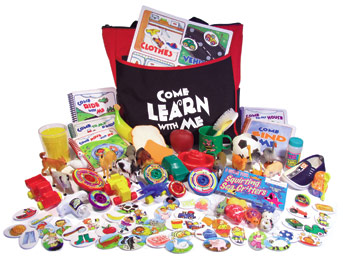Every speech-language pathologist yearns to grab a bag of goodies that will amuse, entice and teach their preschoolers the foundation of language, building the basics for communication and literacy.
“Come Learn With Me” is my goody bag of choice! Use it yourself and share it with parents. Save the precious time of collecting props and pictures and unzip this set of books, objects and pictures to begin assessing and teaching receptive and expressive language and cognitive skills. Clearly the authors’ 30 years of combined early childhood experience is evident in this well organized, complete, simple to use tool with step-by-step lessons. They have anticipated developmental stages and what would be most useful to stimulate them.
Each area of development—receptive and expressive language and cognitive development—is broken down into 5-6 skills, progressing from the easiest to the hardest, with complete instructions on how to teach that skill beginning with ages that it is developing, prerequisite skills, sample objectives, baseline data, how to increase that skill and prompts, including modifications for children with visual or physical limitations. With each skill so clearly defined and broken down into activities, parents can easily utilize this manual and kit too. Parents often ask me, “What should my child be doing now?” I could easily refer to the developmental milestones and show what tasks were appropriate for their child’s age.
Therapists, teachers and parents have unlimited options with the bags of vehicles, food, farm animals, and function objects. Everything is kid-sized so they love to play with the objects, while the five books provide simple, colorful, cartoon drawings within the categories of things to ride, on the farm, in your house and moving out and about. With increased emphasis on data collection, therapists can easily record responses in the front cover of each book, using dry erase pens. The illustrations in the books as well as the 66 individual pictures of objects, animals and people by category, are a strength of this teaching tool. Clear enough to keep it simple, but just enough detail to identify the picture; these punchy drawings attract the child. The thick laminated, interchangeable pictures are the right size for a child’s hands while the thrill of ripping off the Velcro and sticking the picture on to the page is just the interaction needed to keep kids engaged.
The simple backdrop of book pages provides the flexibility we want in teaching preschoolers language skills. Kids can identify vocabulary, follow directions, answer questions, and create their own stories as they place their picture discs on each page of the books, interchanging the drawings to create unlimited stories as the groundwork for understanding and using vocabulary, grammar, and concepts. The inherent adaptability of this teaching tool is evident in the fact that I use it with children on the autism spectrum as well as with language and articulation delays or disorders.
Although parts are offered separately, my recommendation would be to buy the whole kit, ultimately saving money by giving you more flexibility and options for language learning.




